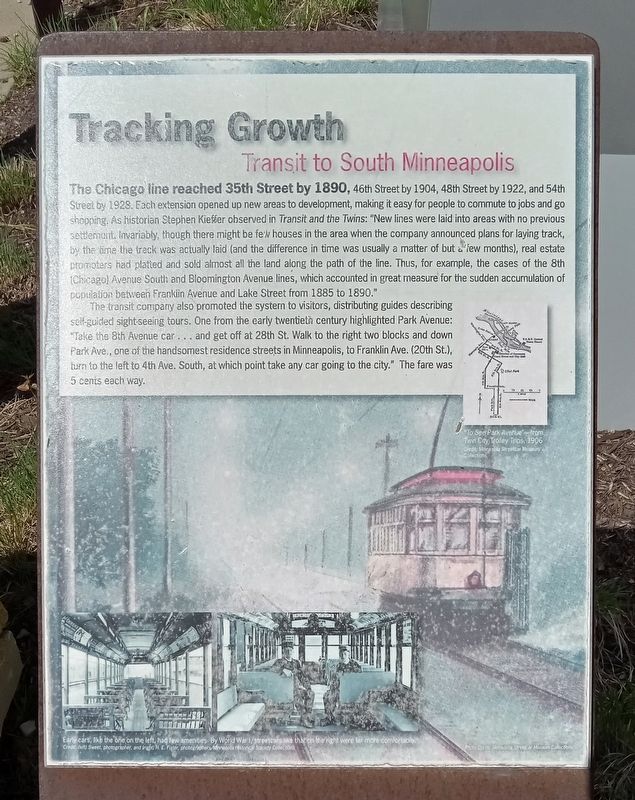Phillips in Minneapolis in Hennepin County, Minnesota — The American Midwest (Upper Plains)
Tracking Growth
Transit to South Minneapolis
The Chicago line reached 35th Street by 1890, 46th Street by 1904, 48th Street by 1922, and 54th Street by 1928. Each extension opened up new areas to development, making it easy for people to commute to jobs and go shopping. As historian Stephen Kieffer observed in Transit and the Twins: "New lines were laid into areas with no previous settlement. Invariably, though there might be a few houses in the area when the company announced plans for laying track, by the time the track was actually laid (and the difference in time was usually a matter of but a few months), real estate promoters had platted and sold almost all the land along the path of the line. Thus, for example, the cases of the 8th [Chicago] Avenue South and Bloomington Avenue lines, which accounted in great measure for the sudden accumulation of population between Franklin Avenue and Lake Street from 1885 to 1890."
The transit company also promoted the system to visitors, distributing guides describing self-guided sight-seeing tours. One from the early twentieth century highlighted Park Avenue: "Take the 8th Avenue car . . . and get off at 28th St. Walk to the right two blocks and down Park Ave., one of the handsomest residence streets in Minneapolis, to Franklin Ave. (20th St.), turn to the left to 4th Ave. South, at which point take any car going to the city." The fare was 5 cents each way.
"To See Park Avenue"—from Twin City Trolley Trips, 1906
Credit: Minnesota Streetcar Museum Collections
Early cars, like the one on the left, had few amenities. By World War I, streetcars like that on the right were far more comfortable.
Credit: (left) Sweet, photographer, and (right) H.E. Fister, photographers/Minnesota Historical Society Collections.
Topics. This historical marker is listed in these topic lists: Railroads & Streetcars • Settlements & Settlers. A significant historical year for this entry is 1890.
Location. 44° 57.34′ N, 93° 15.771′ W. Marker is in Minneapolis, Minnesota, in Hennepin County. It is in Phillips. Marker is at the intersection of E. 26th Street and Chicago Avenue, on the right when traveling west on E. 26th Street. Touch for map. Marker is at or near this postal address: 720 E 26th Street, Minneapolis MN 55404, United States of America. Touch for directions.
Other nearby markers. At least 8 other markers are within walking distance of this marker. Crosstown (here, next to this marker); The Man Behind the Name (here, next to this marker); Fun Fare (here, next to this marker); Horse Car, Streetcar, Bus (here, next to this marker); Passed by a Bus (here, next to this marker); An Era of New Business on the Rail Corridor
(approx. 0.4 miles away); 2845 10th Avenue South: Elevator X (approx. half a mile away); Minneapolis in the Age of Grade Separation (approx. half a mile away). Touch for a list and map of all markers in Minneapolis.
Credits. This page was last revised on April 19, 2024. It was originally submitted on February 9, 2024, by McGhiever of Minneapolis, Minnesota. This page has been viewed 44 times since then. Photos: 1, 2. submitted on February 9, 2024, by McGhiever of Minneapolis, Minnesota. • Andrew Ruppenstein was the editor who published this page.

